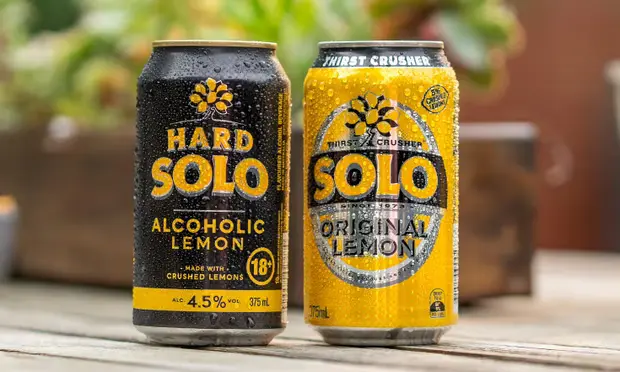
Hard seltzer, also known as spiked seltzer or hard solo, has become a trendy beverage choice among Australians, known for its refreshing taste and lower calorie count compared to other alcoholic drinks. But what exactly goes into a can of hard seltzer, and What alcohol is in hard solo? Let’s dive into the details of these drinks and uncover the types of alcohol used to make them so appealing.
What is hard seltzer?
Hard alcohol is a mix of sparkling water, liquor, or alcoholic beverage and a combination of either natural or artificial flavouring that adds some kick to its taste while also having carbon dioxide that provides fizziness to the drink. The beverage is flavored with a variety of fruits and has very low alcohol content. In particular, Australians are fond of drinking hard seltzers, especially in the summer, as hard seltzer is extremely refreshing.
The origins of hard seltzer
Hard seltzer takes its roots in the United States, where it began to grow in stature with the refreshing qualities and a lower calorie count. Pioneering brands such as White claw started the trend, which has now become a global phenomenon with many different brands creating hard seltzer products according to the local market. In Australia, this particular drink gained traction due to the fact that it could be consumed during outdoor festivities and events.
What type of alcohol is in hard seltzer?
Depending on the brand, the alcohol in these hard seltzers can differ, but they mostly come from one of the following three sources:
- Fermented cane sugar: Fermented cane sugar is the most popular alcohol base, as it is used the most as it produces a good, clean neutral alcohol that can be used along with multiple flavorings.
- Malted barley: Malted barley is a common base that is also made with some brands of beer. However, most malted hard seltzers are heavily filtered to ensure that the drink remains light and, when consumed, has a clean, refreshing taste.
- Distilled spirits: only a few brands will use distilled spirits as a base for their alcohol, such as vodka. While this method may give the drink a little distinct taste, there is a chance that the alcohol content will be just a little higher than usual.
Alcohol content in hard seltzer
Many seltzers have an alcohol by volume ABV percentage of between 4 to 6% which makes them quite similar to beers. The ABV JB as well as its calorie count help in keeping hard seltzer appealing while one just wants a casual drink. Let’s take a closer look at its ABV properties:
- Moderate strength: The ABV JB also allows hard seltzer to be enjoyed in social gatherings with a lighter drink preference.
- Portion control: As each can is portioned, it makes it easier for you to keep track of your intake, especially for those who want to drink mildly. By doing so, a moderate foundation will be established.
- Ideal for summer: The fact that its alcohol ABV ranges between 4 and 6 percent means that you get a refreshing drink without feeling weighted down by some overpowering options, and thus, it is ideal to be used on hot Australian days.
Nutritional benefits of hard seltzer
When it comes to health aware consumers, hard seltzer has quite a few interesting features. Plus, most Seltzers even have a low calorie and low sugar content as compared to a wide range of alcoholic beverages, which works great for health-conscious consumers.
1. Lower calorie content
A standard hard seltzer can has around 90-100 depending on the brand, but a beer or wine on a certain brand average can have a much larger caloric intake; thus, seltzers are much better for Australians that try to control their diets.
2. Reduced sugar content
Almost all hard seltzers have little to no sugar addition, which lowers their caloric content while retaining a subtle yet sweet taste the drinker would enjoy. This appeals best to those who want a treat while cutting their sugar intake.
3. Gluten-free options
Because the great majority of these hard seltzers are fermented cane sugar, they are gluten-free. This is good news for folks who have gluten sensitivities or celiac disease since they would otherwise have to stay away from beer and other gluten-containing beverages.
Popular hard seltzer brands in Australia
In Australia, there are a variety of flavors and drinking strategies across many brands of Hard Seltzer. Its major options include, but are not limited to the following:
- White Claw: Australians seem to have a growing appreciation for White Claw, whose presence has managed to expand as a result of its varied geographic coverage and vast range of products. These include flavors such as classic lime and raspberry, as well as more elevated flavors impersonating mango and black cherry.
- Fellr: This brand is Australian owned and made and focuses heavily on Nazare’s natural ingredients. The brand has a wider range of products, growing in demand, which includes watermelon, lime & soda, and tropical.
- Smirnoff Seltzer: Seltzers from the brand Smirnoff are widely spread across Australia and come in traditional flavors based on fruits such as lime, raspberry, and passion fruit. They have made a name for themselves because of their great taste and standard quality.
Why Australians love hard seltzer
There are a number of reasons why hard seltzers are on the rise in Australia, and most of them are out of respect for the Australian lifestyle and culture of its people:
1. Health-conscious choice
Members of Australian society are starting to shift their focus towards health and wellness, and bitter seltzers make this possible by being low calorie and low sugar content. Because of its low calorie and carb content, bitter seltzer has caused a change in drinking culture.
2. Variety of flavours
Lime, watermelon, lemon, and mango are some of the many mixed fruit flavors that hard seltzers present to the Australian market. This enables Australians the chance to select alternatives that fit their taste preferences; hence, seltzer becomes a flexible drink that can be used to inform of a variety.
3. Convenience and portability
Hard Seltzer can be conveniently taken in its ready to drink format in a can as it can easily be poured in a glass. Lightweight cans are easy to carry and serve, fitting well in the Australian summer lifestyle. Due to their moderate alcohol content, they are the preferred alcohol choice during social events.
Hard seltzer vs other alcoholic drinks
Hard seltzer stands out from other alcoholic drinks due to its unique properties.
- Lower calorie count: Hard seltzer contains fewer calories than many beers, wines, and cocktails, making it ideal for those trying to limit their calorie intake.
- Less sugar: Hard seltzer usually has no sugar added, which can be beneficial for an individual with concern on their sugar intake.
- Gluten-free: Hard seltzer is a better option for people who are gluten sensitive or suffer from gluten allergies since the majority of hard seltzers don’t contain gluten as opposed to beer.
How does hard seltzer compare to beer?
Integration of carbs, sugars, and calories is a critical aspect when considering the brewing process of beer, especially in craft beer. The grains used in the production process contains gluten, as barley or wheat is used. This can cause problems for individuals who are gluten sensitive. On the other hand, there are people who want to cut down these elements from their diet, and for such individuals, hard seltzer stands out as a potential option as it is a gluten-free, low-calorie, and low-sugar option.
How does hard seltzer compare to wine?
Sweet and dessert wines can have a high concentration of sugar content. Specifically, wines have a high ABV. However, wines are usually consumed with meals rather than for casual purposes and tend to have a stronger flavor with the ability to dominate. In opposition, hard seltzers high due to its fizziness and lower ABV have been enjoyable, which also explains its popularity for daytime drinking.
Tips for choosing the best hard seltzer
When it comes to hard seltzers, there are certain aspects you need to keep in the back of your head, and they are those that allow the seltzer to be aligned to your liking:
- Check the ABV: The concentration when it comes to hard seltzers mostly sits between 4%-6%. If a person, however, is looking for more of a subtle feel, picking a hard seltzer from the lower spectrum would be worth it.
- Look for natural flavours: The extracted fruit that is used in the process is natural. This helps with the seltzer taste. In order to enjoy a seltzer one is suggested to look for a specific flavor.
- Consider gluten-free options: For those having gluten issues, it is necessary to verify that the hard seltzer in question is specifically labeled gluten free so as not to exacerbate one’s condition.
Hard seltzer: A refreshing choice for Australians
There will always be a market for hard seltzer among Australians, and from the look of things, that appeal to the sieves does not seem to me to be fading anytime soon. Hard seltzer has established itself in Australia as a healthy, low-calorie drink option with subtle flavors so perfectly blended that they can complement just about any meal. Whether you are headed to the beach, doing a barbeque, or just coming back from work, hard seltzer will provide you with a great way to cool down.
Conclusion
Australia’s hard seltzer’s popularity could have partially been attributed to its low sugar, low calories, and alcohol-infused taste that’s hard to forget. Hard seltzer is great for Australians who enjoy a tasty helping hand on their quest to be healthy and do not mind exerting some efforts to drink healthier. Most households in Australia now have hard seltzer because of the flavors, easy-to-carry cans, and gluten-free seltzer. Waves are already in the market as there is a hard seltzer aimed at every audience; it’s only a matter of time before seltzers become a new norm in Austrailian gatherings for people who are trying it out or are already fans of it.





